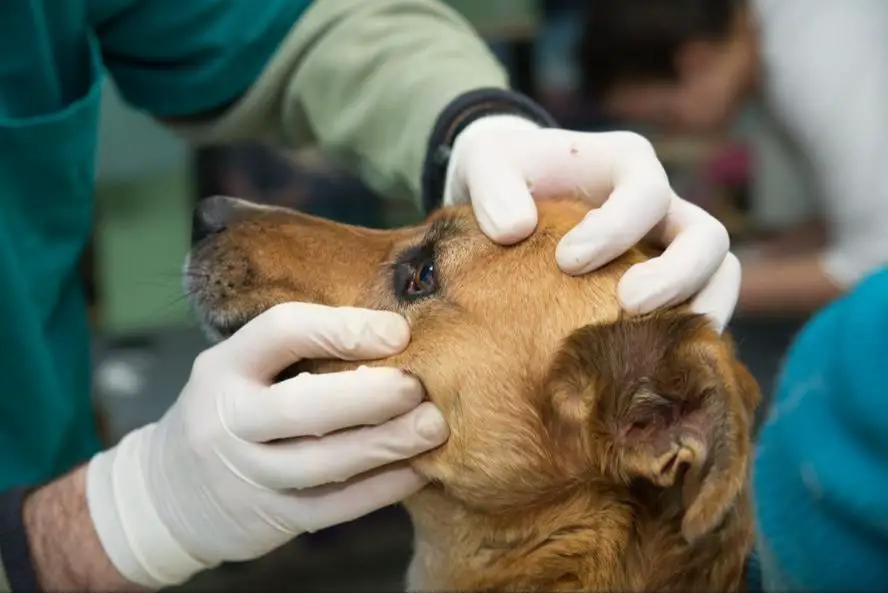Introduction
Crossed eyes, also known as strabismus, is a condition where a dog’s eyes are not properly aligned with each other. One or both of the dog’s eyes will turn either inward, towards the nose, or outward, towards the ears. This results in the dog seeing double images or having otherwise impaired vision. The purpose of this article is to provide an overview of crossed eyes in dogs – defining the condition, outlining causes and symptoms, treatment options, and advice for living with a dog with strabismus.
What Causes Crossed Eyes in Dogs?
There are several potential causes of crossed eyes, also known as strabismus, in dogs:

Genetics: Some dog breeds like Boston Terriers, Bulldogs, and Pugs are genetically predisposed to developing strabismus. The genes responsible for eye development may cause eyes to be misaligned from birth.
Birth Defects: During fetal development in the womb, errors can occur that affect proper eye positioning and muscle control. This can lead to eyes that point in different directions.
Injuries: Trauma to a dog’s head or eyes due to an accident or injury may cause strabismus if the muscles or nerves controlling eye movement are damaged. This includes things like car accidents, falls, or blunt force.
Underlying Medical Conditions: Sometimes crossed eyes are a symptom of other medical issues like eye infections, glaucoma, or brain tumors that affect the nerves related to eye positioning and movement.
Aging: Muscle weakness and loss of control as a dog ages can result in eyes crossing later in life. Older dogs are more prone to developing acquired forms of strabismus.
Symptoms of Crossed Eyes
Dogs with crossed eyes, also known as strabismus, will have eyes that are misaligned and pointed in different directions. One or both eyes may turn either inward (esotropia) or outward (exotropia). The degree to which the eyes are crossed can vary from mild to severe.
With crossed eyes, the dog’s gaze is not properly aligned between the two eyes, which causes problems with depth perception and vision. Things may appear closer or farther away than they actually are, making it difficult for dogs to judge distances accurately when navigating or catching objects. They may have trouble seeing things directly in front of their face if the eyes are severely turned.
Vision may be blurry or double in one or both eyes. Dogs with strabismus often tilt their heads to use just one eye at a time for seeing clearly. Their eyes may dart back and forth instead of moving in unison when scanning their environment. Excessive squinting, rubbing at the eyes, or crusty discharge are also common symptoms.
Diagnosing Crossed Eyes
To confirm a crossed eyes (strabismus) diagnosis in dogs, veterinarians will perform several exams and tests. The initial appointment will involve a full physical exam to look for potential underlying causes like trauma, neurological issues, or eye injury.

The vet will observe the dog’s eyes to evaluate the direction, frequency and variability of the misalignment. They will check the pupillary light reflex by shining a light in each eye to see if the pupils constrict normally. Exophthalmometry may be used to measure if one eyebulge protrudes abnormally.
If an underlying cause isn’t found, the vet may administer medication to evaluate if the eyes straighten when given acetylcholine or atropine. This helps determine if the misalignment is due to a structural defect or neuromuscular problem. Additional tests like CT or MRI scans may be recommended to check for issues with the eye muscles or nerves.
Veterinary ophthalmologists can perform more specialized exams to fully evaluate the eyes. These may include a Schirmer tear test, tonometry, slit lamp exam, corneal staining, gonioscopy, and fundic exam. The results help diagnose specific eye conditions contributing to the crossed eyes.
Treatment Options
There are several treatment options available for dogs with crossed eyes (strabismus):
Surgery – This is the most common and effective treatment for strabismus in dogs. Surgery can realign the eye muscles to put the eyes back into proper alignment. The specific surgical procedure will depend on which muscles are malformed and the severity of the misalignment.
Vision therapy – Also called eye exercises, this involves doing special activities with your dog to strengthen the eye muscles and improve coordination between the eyes. Things like having them track toys or treats can help improve vision and eye alignment. This is sometimes done along with surgery.
Medication – Certain medications like atropine eye drops may be prescribed in some cases to help relax the eye muscles. This can temporarily reduce the crossed eyes appearance and eye strain. However, medication alone usually does not completely fix strabismus.
Eye patches – Covering or patching one eye may be recommended to force the weaker eye to work harder and strengthen its muscles. This is often paired with vision therapy.
Consult with your veterinarian to determine the right treatment approach based on your dog’s specific case, degree of misalignment, and cause of the strabismus.
Surgery for Crossed Eyes
Surgery is a common treatment option for correcting crossed eyes in dogs. The goal of surgery is to realign the muscles and tissues around the eye to put the eye back into proper alignment. This is done by tightening, loosening, or reattaching certain eye muscles.

There are a few different surgical techniques that can be used depending on the underlying cause and severity of the dog’s crossed eyes. Some options include:
- Recession: Detaching and repositioning eye muscles further back to weaken their pulling action
- Resection: Removing a portion of an eye muscle to weaken it
- Transposition: Switching the places of two eye muscles to change their pulling direction
The surgery is performed under general anesthesia. The veterinary ophthalmologist will make small incisions around the eye to access the muscles. Stitches are used to hold the repositioned muscles in place. The procedure typically takes 1-2 hours depending on the technique used.
There are some risks with eye surgery including infection, bleeding, swelling, and recurrence of the crossed eyes. Proper wound care and medications will be needed during the recovery period to minimize complications. It can take several weeks for the eyes to completely heal and align properly after surgery.
Most dogs tolerate the surgery well and have improved vision afterwards. However, some dogs may continue to have residual eye misalignment or limited vision, especially if the condition was present from birth. Regular follow-ups with the veterinary ophthalmologist are recommended to monitor progress after corrective surgery.
Living with a Cross-Eyed Dog
While crossed eyes in dogs may seem like just a cosmetic issue, it can actually cause some functional problems for your pup. Here are some tips for living with and managing a cross-eyed dog:
- Watch out for depth perception issues. Your dog may have trouble judging distances and stairs. Go slowly on walks and provide ramps/stairs where needed.
- Get down on your dog’s level. Look straight at them from a few feet away so they can focus on you. Use hand signals along with verbal commands.
- Consider modifying their environment. Reduce clutter, rearrange furniture they may bump into, and remove trip hazards.
- Feed on a raised bowl or mat. This brings the food closer and makes it easier for them to see.
- Avoid moving things suddenly. Cross-eyed dogs startle more easily, so move slowly around them.
- Keep their face clean. Excessive tearing or discharge can blur their vision even more.
- Use toys that squeak or make noise so they’re easier to locate.
- Keep their routine consistent and familiar so they can navigate easily.
While crossed eyes can present some challenges, your dog can still live a happy, active life. With some simple modifications and awareness, you can help them manage their limited vision.
Long Term Prognosis
The long term prognosis for dogs with crossed eyes depends on the underlying cause and treatment plan. In some cases, vision or eye alignment may improve over time, while in other cases the condition is permanent. With appropriate treatment and management, most dogs can live happily despite having crossed eyes.
For dogs with congenital strabismus that is left untreated, the outlook is poor for developing normal vision. The brain learns to ignore input from the misaligned eye, leading to permanent loss of vision in that eye over time. However, with early surgical correction, the prognosis for vision is good. The earlier surgery is performed, the better the chances of restoring proper eye alignment and binocular vision.
For dogs with acquired strabismus due to disease, inflammation, or injury, the prognosis depends on the ability to address the underlying condition. With treatment of the root cause and/or strabismus surgery, vision and eye alignment may significantly improve. However, some dogs may be left with residual vision deficits or misalignment.
Dogs adapt incredibly well to monocular vision or having crossed eyes. With time, they learn to compensate and can enjoy a good quality of life. Owners can help by ensuring their living space is safe, avoiding excessive jumping/stairs, and monitoring for any secondary issues. While crossed eyes may be an aesthetic issue for owners, most dogs pay little attention to their appearance and remain happy and playful.
Prevention
There are some steps dog owners can take to help prevent injuries or conditions that may lead to crossed eyes in dogs:

-
Use a harness instead of a collar when walking or training dogs. Collars can put pressure on the neck and throat, potentially causing eye injuries.
-
Keep dogs away from roughness during play. Avoid letting dogs play with sticks or other objects that could poke the eye.
-
Protect dogs’ eyes from ultraviolet light exposure. Consider doggie sunglasses or eye drops on sunny days.
-
Clean dogs’ eyes daily with a warm, wet cloth to prevent infections.
-
Feed a nutritious diet with antioxidants. Vitamins E and C support eye health.
-
Avoid exposure to irritants like dust, pollen, or smoke that could cause eye inflammation.
-
Have dogs’ eyes examined annually by a veterinarian as part of a routine wellness check.
While not every case of crossed eyes can be prevented, these precautions can reduce the chances of an injury or condition leading to strabismus in dogs.
When to See a Vet
If a dog’s eyes suddenly start pointing in different directions, this is considered an emergency and requires immediate veterinary attention. Sudden changes in eye alignment could signal a more serious underlying neurological issue such as a stroke, brain tumor, trauma, infection, or reaction to toxin. Dogs experiencing a sudden onset of strabismus should be evaluated as soon as possible.
You should also seek prompt veterinary care if your dog’s eyes appear red, swollen, or painful. Other concerning symptoms that warrant a trip to the vet include crusty discharge around the eyes, pawing at the eyes, excessive blinking or tearing, and behavioral changes. Your vet can perform a full ophthalmic exam and look for any abnormality or injury that could be causing pain or vision issues. Treatment depends on the underlying cause but may include eye drops, ointments, medication, or surgery.
As with any other concerning symptom in a pet, it’s always best to have a veterinary professional evaluate the situation as soon as possible. When it comes to eye issues, early intervention is important for preventing long-term damage and vision loss. Schedule an appointment with your vet right away if your dog develops strabismus or other eye problems that appear abnormal or painful.